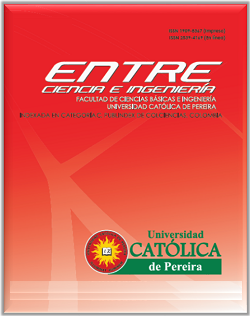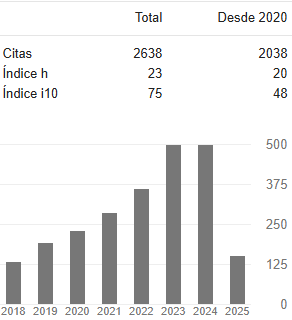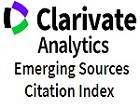Una herramienta para el análisis de índices espectrales para la detección remota de vegetación y cultivos utilizando imágenes hiperespectrales
DOI:
https://doi.org/10.31908/19098367.1161Palabras clave:
Imágenes hiperespectrales, sensado remoto, bandas espectrales, índice de vegetación, longitud de ondaResumen
Los requerimientos alimentarios en el mundo han aumentado, evidenciando la necesidad de mejorar las técnicas estándar de producción agrícola. Para abordar este problema, una alternativa de solución es la inclusión de elementos tecnológicos como el sensado remoto de vegetación y los cultivos a partir de imágenes hiperespectrales. El sensado remoto y las imágenes hiperespectrales son métodos no invasivos, que permiten monitorear grandes espacios de terreno en cantidades de tiempo reducidas. Estas características han hecho que el sensado remoto a partir de imágenes hiperespectrales sea una herramienta poderosa para desarrollo de procesos de agricultura de precisión. En este artículo se presenta una aplicación de software que permite generar y procesar índices espectrales de vegetación y sus respectivas imágenes de pseudo color, utilizando imágenes hiperespectrales. Las imágenes hiperespectrales utilizadas fueron tomadas de la base de datos del sensor Airborne Visible-Infrared Imaging Spectrometer (AVIRIS), diseñado por la NASA. El objetivo de la aplicación de software es mostrar diferentes elementos asociados con el monitoreo remoto de vegetación y cultivos a partir de imágenes hiperespectrales. Finalmente, se presentan pruebas funcionales para verificar el cumplimiento de los requisitos del software.
Descargas
Referencias
Thenkabail, P. S., Lyon, J. G., and Huete, A. Hyperspectral remote sensing of vegetation. 2012.
El-Hendawy, S., Al-Suhaibani, N., Salem, A. E., Rehman, S. U., and Schmidhalter, U. “Spectral reflectance indices as a rapid and nondestructive phenotyping tool for estimating different morphophysiological traits of contrasting spring wheat germplasms under arid conditions,” Turkish J. Agric. For., vol. 39, no. 4, p. 572, 2015.
Jiang, C., and Su, G. “A review of remote sensing image fusion methods,” Sci. Direct Agric. Inf. Fusion, vol. 32, no. March, pp. 75–89, 2016.
Loncan, L., et al. “Hyperspectral pansharpening : a review,” vol. 2015, no. september, pp. 1–15, 2015.
Gago, J., et al. “UAVs challenge to assess water stress for sustainable agriculture,” Sci. Direct Agric. Agric. Water Manag., vol. 153, pp. 9–19, 2015.
Sun, P., et al. “International Journal of Remote Associated changes in physiological parameters and spectral reflectance indices in olive ( Olea europaea L .) leaves in response to different levels of water stress,” Int. J. Remote Sens., vol. 29, no. 6, pp. 1725–1743, 2008.
Zhang, J., Wu, J., and Zhou, L. “Deriving vegetation leaf water content from spectrophotometric data with orthogonal signal correction-partial least square regression,” Int. J. Remote Sens., vol. 32, no. 22, pp. 7557–7574, 2011.
Elarab, M., Ticlavilca, A. M., Torres, A. F., Maslova, I., and McKee, M. “Estimating chlorophyll with thermal and broadband multispectral high resolution imagery from an unmanned aerial system using relevance vector machines for precision agriculture,” Int. J. Appl. Earth Obs. Geoinf., vol. 43, pp. 32–42, 2015.
Babar, M. A., Reynolds, M. P., Van Ginkel, M., Klatt, A. R., Raun, W. R., and Stone, M. L. “Spectral reflectance indices as a potential indirect selection criteria for wheat yield under irrigation,” Crop Sci. Soc. Am., vol. 46, no. 2, pp. 578–588, 2006.
Lira, J. Tratamiento Digital de Imágenes - Universidad Nacional Autónoma de México, vol. 1. 2010.
Ramoelo, A., et al. “Monitoring grass nutrients and biomass as indicators of rangeland quality and quantity using random forest modelling and WorldView-2 data,” Int. J. Appl. Earth Obs. Geoinf., vol. 43, pp. 43–54, 2015.
Carter, G., and Knapp, K. “Leaf optical properties in higher plants: linking spectral characteristics to stress and chlorophyll concentration.,” Am. J. Bot., vol. 88, no. 4, pp. 677–684, 2001.
Zhang, J., Wu, J., and Zhou, L. “Deriving vegetation leaf water content from spectrophotometric data with orthogonal signal correction-partial least square regression,” Int. J. Remote Sens., vol. 32, no. 22, pp. 7557–7574, 2011.
Schlerf, M., Atzberger, C., and Hill, J. “Remote sensing of forest biophysical variables using HyMap imaging spectrometer data,” Remote Sens. Environ., vol. 95, no. 2, pp. 177–194, 2005.
Palsson, F., Sveinsson, J. R., Ulfarsson, M. O., and Benediktsson, J. A. “Model-Based Fusion of Multi- and Hyperspectral Images Using PCA and Wavelets,” IEEE Trans. Geosci. Remote Sens., vol. 53, no. 5, pp. 2652–2663, 2015.
Kalacska, M., Sanchez, G. A., Rivard, B., Caelli, T., White, H. P., and Calvo, J. C. “Ecological fingerprinting of ecosystem succession: Estimating secondary tropical dry forest structure and diversity using imaging spectroscopy,” Remote Sens. Environ., vol. 108, no. 1, pp. 82–96, 2007.
Basaeed, E., Bhaskar, H., and Al-mualla, M. “Beyond Pan-sharpening : Pixel-level Fusion in Remote Sensing Applications,” Int. Conf. Innov. Inf. Technol., pp. 139–144, 2012.
Rational Software White Paper, “Rational Unified Process Best Practices for Software,” 2004.
J. P. L. NASA, “AVIRIS Airborne Visible/InfraRed Imaging Spectrometer,” Calif. Inst. Technol., 2017.
Posada, E., Mauricio, H., Daza, Carolina, R., N., and Delgado, E. Manual de prácticas de percepción remota con el programa ERDAS IMAGINE 2011. 2011.
Descargas
Publicado
Número
Sección
Licencia
Derechos de autor 2020 Entre Ciencia e Ingeniería

Esta obra está bajo una licencia internacional Creative Commons Atribución-NoComercial 4.0.



















